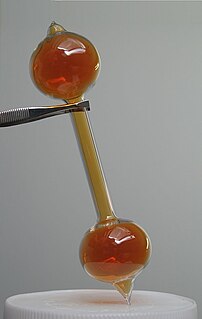The Stefan flow, occasionally called Stefan's flow, is a transport phenomenon concerning the movement of a chemical species by a flowing fluid (typically in the gas phase) that is induced to flow by the production or removal of the species at an interface. Any process that adds the species of interest to or removes it from the flowing fluid may cause the Stefan flow, but the most common processes include evaporation, condensation, chemical reaction, sublimation, ablation, adsorption, absorption, and desorption. It was named after the Austrian physicist, mathematician, and poet Josef Stefan for his early work on calculating evaporation rates.
A chemical species is a chemical substance or ensemble composed of chemically identical molecular entities that can explore the same set of molecular energy levels on a characteristic or delineated time scale. The term is applied equally to a set of chemically identical atomic or molecular structural units in a solid array.
In physics, a fluid is a substance that continually deforms (flows) under an applied shear stress, or external force. Fluids are a phase of matter and include liquids, gases and plasmas. They are substances with zero shear modulus, or, in simpler terms, substances which cannot resist any shear force applied to them.

In physics and engineering, fluid dynamics is a subdiscipline of fluid mechanics that describes the flow of fluids—liquids and gases. It has several subdisciplines, including aerodynamics and hydrodynamics. Fluid dynamics has a wide range of applications, including calculating forces and moments on aircraft, determining the mass flow rate of petroleum through pipelines, predicting weather patterns, understanding nebulae in interstellar space and modelling fission weapon detonation,
The Stefan flow is distinct from diffusion as described by Fick's law, but diffusion almost always also occurs in multi-species systems that are experiencing the Stefan flow. [1] In systems undergoing one of the species addition or removal processes mentioned previously, the addition or removal generates a mean flow in the flowing fluid as the fluid next to the interface is displaced by the production or removal of additional fluid by the processes occurring at the interface. The transport of the species by this mean flow is the Stefan flow. When concentration gradients of the species are also present, diffusion transports the species relative to the mean flow. The total transport rate of the species is then given by a summation of the Stefan flow and diffusive contributions.

Diffusion is the net movement of molecules or atoms from a region of higher concentration to a region of lower concentration. Diffusion is driven by a gradient in chemical potential of the diffusing species.
An example of the Stefan flow occurs when a droplet of liquid evaporates in air. In this case, the vapor/air mixture surrounding the droplet is the flowing fluid, and liquid/vapor boundary of the droplet is the interface. As heat is absorbed by the droplet from the environment, some of the liquid evaporates into vapor at the surface of the droplet, and flows away from the droplet as it is displaced by additional vapor evaporating from the droplet. This process causes the flowing medium to move away from the droplet at some mean speed that is dependent on the evaporation rate and other factors such as droplet size and composition. In addition to this mean flow, a concentration gradient must exist in the neighborhood of the droplet (assuming an isolated droplet) since the flowing medium is mostly air far from the droplet and mostly vapor near the droplet. This gradient causes Fickian diffusion that transports the vapor away from the droplet and the air towards it, with respect to the mean flow. Thus, in the frame of the droplet, the flow of vapor away from the droplet is faster than for the pure Stefan flow, since diffusion is working in the same direction as the mean flow. However, the flow of air away from the droplet is slower than the pure Stefan flow, since diffusion is working to transport air back towards the droplet against the Stefan flow. Such flow from evaporating droplets is important in understanding the combustion of liquid fuels such as diesel in internal combustion engines, and in the design of such engines. The Stefan flow from evaporating droplets and subliming ice particles also plays prominently in meteorology as it influences the formation and dispersion of clouds and precipitation.

In physics a vapor or vapour is a substance in the gas phase at a temperature lower than its critical temperature, which means that the vapor can be condensed to a liquid by increasing the pressure on it without reducing the temperature. A vapor is different from an aerosol. An aerosol is a suspension of tiny particles of liquid, solid, or both within a gas.
In science and engineering, a system is the part of the universe that is being studied, while the environment is the remainder of the universe that lies outside the boundaries of the system. It is also known as the surroundings or neighborhood, and in thermodynamics, as the reservoir. Depending on the type of system, it may interact with the environment by exchanging mass, energy, linear momentum, angular momentum, electric charge, or other conserved properties. In some disciplines, such as information theory, information may also be exchanged. The environment is ignored in analysis of the system, except in regard to these interactions.
In physics, a frame of reference consists of an abstract coordinate system and the set of physical reference points that uniquely fix the coordinate system and standardize measurements.








